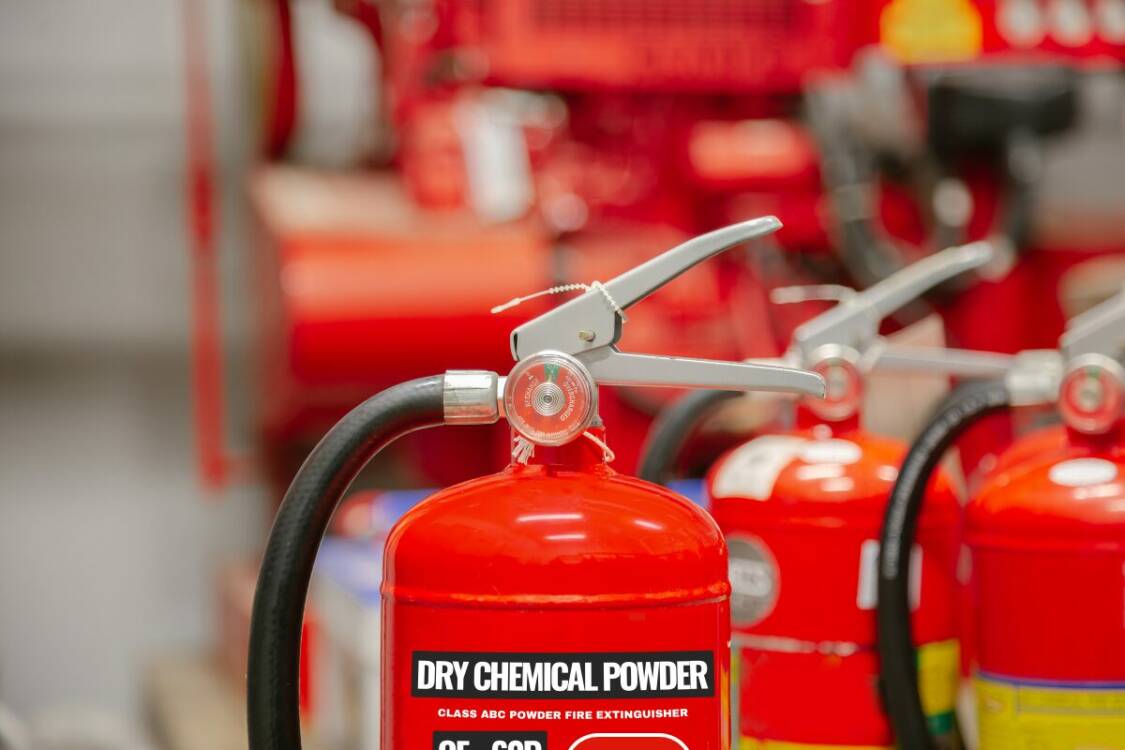This article goes over the fundamental fire extinguisher requirements for inspections, testing, maintenance, placement, and more. That way, you can easily master the basics!
Stepping into the world of fire safety can be overwhelming. There are so many different safety codes, regulations, and specific requirements to keep track of. It can literally feel like trying to drink from a fire hose! Thankfully, we are here to help.
This article aims to take the main requirements for portable fire extinguishers and distill them into an easy read, making it feel more achievable to actually grasp what is necessary and important to know. After all, you have a lot going on, and being able to memorize and read over every code just isn’t going to happen.
However, this article will equip you with the essentials for getting started. You can expect to read this overview of fire extinguisher requirements and walk away with knowledge of the most common regulations for fire extinguishers and where they come from. So, let’s get into it.
Portable Fire Extinguisher Codes
There are 2 primary safety standards that provide fire extinguisher requirements: NFPA 10 and OSHA 1910.157. These standards offer the most current, widely-accepted information and guidelines for fire extinguisher upkeep. Familiarity with these standards can help technicians thoroughly and reliably meet the industry requirements.
| Code | Description |
|---|---|
| NFPA 10 | NFPA 10 is a fire safety standard established by the National Fire Protection Association that presents currently accepted methods for preserving and using portable fire extinguishers. This fire extinguisher code provides technicians with the necessary information to properly perform inspections, testing, and maintenance (ITM) on fire extinguishers. Additionally, it dives into topics such as the selection, installation, and recharging of portable fire extinguishers. NFPA 10 is a resource for inspectors, managers, and safety professionals alike, as it can help with performing duties and maintaining a safe environment. Though compliance with it isn’t government-mandated or enforced, many choose to follow its guidance and consider it the guidebook of industry “best practices”. |
| OSHA 1910.157 | OSHA 1910.157 is a workplace safety standard established by the Occupational Health and Safety Administration that details government-enforced regulations for portable fire extinguishers. Similar to NFPA 10, this standard is designed to provide employers and their workers with necessary information regarding the “placement, use, maintenance, and testing of portable fire extinguishers.” Unlike the NFPA, whose standards are followed on a voluntary consensus, OSHA standards mandate compliance and can result in fines for violations. Becoming familiar with these two fire extinguisher standards is one of the best ways to prepare for any inspection, testing, or maintenance activities. To learn more about these fire extinguisher codes, see our article here. |
Becoming familiar with these two fire extinguisher standards is one of the best ways to prepare for any inspection, testing, or maintenance activities. To learn more about these fire extinguisher codes, see our article here.

Fire Extinguisher Requirements: Placement
Fire extinguishers are only as useful as they are accessible. As a result, fire extinguisher requirements have been established to ensure that they are placed within a reasonable range for use.
The placement of fire extinguishers not only helps to maximize safety, but it also makes it easier for you to locate them and perform your maintenance duties. When it comes to fire extinguisher placement, here are 4 factors to consider: the height it will be affixed at, the distance someone would have to travel to retrieve it, its visibility, and the general location/occupancy type.
Proper Care for Portable Fire Extinguishers
Now, let’s go over the main fire extinguisher requirements regarding equipment upkeep.
Monthy Visual Inspections
Monthly visual inspections are quick evaluations of fire extinguishers to make sure they are fully charged, free of damage, and ready for use. They can be performed by any trained employee and are to be conducted during installation and every 30 days following that (basically monthly).
Here are some of the main things to check for:
- Extinguishers are in their designated locations and properly mounted.
- There are no obstructions to visibility/access.
- The container has adequate pressure (between 185 – 195 PSI).
- The fire extinguisher is full – confirmed by weighing or lifting.
- Exterior is free of any damage – corrosion, leakage, clogged nozzle.
- There are no missing or broken safety seals.
- Operating instructions are intact and legible.
Find more details in NFPA 10 (10), Sec. 7.2.
Hydrostatic Testing
Hydrostatic testing is an NFPA 10 requirement (Sec. 8) that involves testing the extinguisher to ensure the structural integrity of the fire extinguisher and certify that it can withstand the pressure related to its use. Only individuals with specialized training, equipment, and skills should perform this test, and the frequency depends on the fire extinguisher classification.
Intervals for the most common fire extinguishers:
- Pressurized water, water mist, carbon dioxide and wet chemical (e.g. K-type) extinguishers – every 5 years
- Dry chemical extinguishers with stainless steel shells – every 5 years
- Dry chemical extinguishers – every 12 years
More information can be found in NFPA 10(10) Sec. 8.3.1.
Maintenance & Care
Maintenance is a broad term that can be applied to many activities relating to fire extinguisher up-keep.
General maintenance includes routine fixes on extinguishers and involves things like recharging, replacements, and cleaning the shell. This can be performed by any trained worker and should be performed whenever monthly visual inspections occur. If there is evidence of damage or additional attention, then the extinguisher should be attended to.
Each year, extinguishers should receive a more in-depth annual maintenance check that looks at all the mechanical parts ((testing seals, operating mechanisms, and reviewing pressure levels). Per the standards, this review must be performed by a certified fire extinguisher inspector at least once a year.
Additionally, extinguishers are to occasionally receive maintenance in the form of internal examinations, which are a form of thorough assessment that looks at the inner components of the fire extinguisher, including the cylinder and valve assembly, to check for damage, corrosion, or wear. These must be performed by a certified professional and happen at varying intervals, depending on the extinguisher type. The most common is every 6 years for a dry chemical, stored pressure fire extinguisher. For more info on internal examinations, see NFPA 10 (10) Sec. 7.3.1.
Software Helps With Fire Extinguisher Requirements
Though software isn’t necessary for managing fire extinguishers, it can make your job a whole lot easier. InspectNTrack software is built specifically for managing fire and life safety programs, and is exceptional at performing all tasks related to fire extinguishers.
Our software is designed to support compliance with both NFPA 10 and OSHA 1910.157 by helping you schedule upcoming maintenance tasks, properly document your efforts, and prove compliance with a thorough data history. Not only that, but it offers location tracking to help you track which extinguishers are where and make logical routes for performing maintenance tasks on them. Additionally, automated reminders can help you keep up with monthly visual inspections and plan for annual maintenance checks, hydrostatic testing, and examinations.
Fire extinguisher software is your tool to seamlessly meet all fire extinguisher requirements. To learn more, connect with our team by requesting a demo!
Conclusion
Fire extinguisher requirements make sure that your equipment is compliant, accessible, and ready for use. However, with so much information, it can be challenging to figure out what you actually need to know and do in order to meet the requirements. This article helps distill all that information down, by providing you with the fundamental fire extinguisher codes, placement regulations, and maintenance action items. By reviewing these main points, you can equip yourself with the knowledge to properly maintain your fire extinguishers and meet the necessary requirements.

